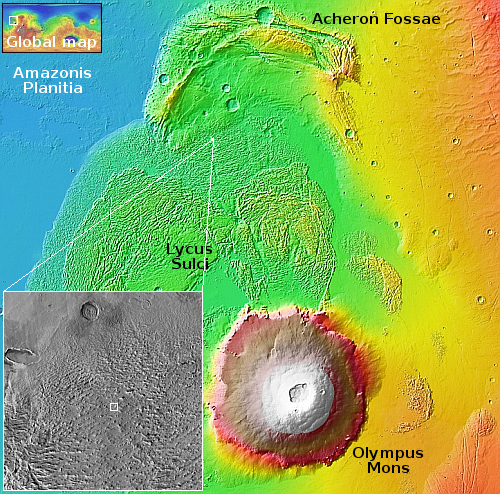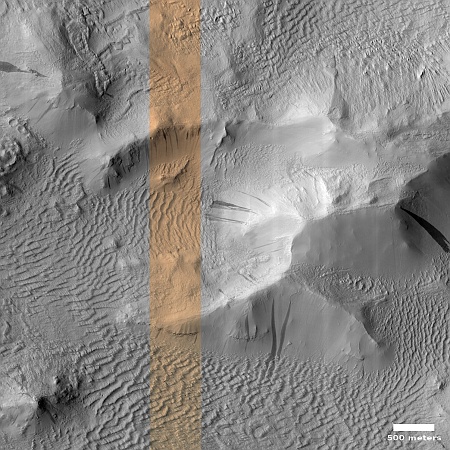Slope streaks within Mars’ largest mountain region

Today’s cool image revisits Lycus Sulci, the largest mountain range on Mars, about 1,400 mile wide and 1,800 miles long. The overview map to the right gives a sense of the roughness and chaotic nature of this region, extending north from Mars’ largest volcano, Olympus Mons.
At present scientists are unsure of the geology that formed Lycus Sulci, and how it is linked with Olympus Mons. The wide view to the right suggests it is the remains of a very ancient lava flow descending from the volcano that over time has become eroded to produce this wildly knobby terrain. That hypothesis remains unproven however. There is also evidence that the material here might instead be volcanic ash, deposited in many layers and eroded away with time.
The location of the cool image below is marked by the white dot, with the inset providing us a wider view of the surrounding terrain. Note the two craters to the north and west. Both appear to have been partly filled by flows coming from the south and east, respectively, adding weight to the theory that this region formed from lava flow.
The picture to the right, rotated, cropped, reduced, and sharpened to post here, was taken on April 30, 2025 by the high resolution camera on Mars Reconnaissance Orbiter (MRO). The largest mesa in the picture is about 500 feet high.
Note the many slope streaks. Lycus Sulci is known for its slope streaks, and most MRO photos of this region seem focused on monitoring these features. In this case this is the first MRO high resolution picture of this particular spot, so it is presently difficult to know how these streaks have changed over time. The origin of these streaks is at present not understood.
Note also the many dunes in the low-lying hollows. This large quantity of dust, likely volcanic ash, suggests strongly that these terrain is layered ash, not lava. Or maybe it is a complex combination of both.
Orbital data cannot answer this question. We need to walk the surface to find out.
On Christmas Eve 1968 three Americans became the first humans to visit another world. What they did to celebrate was unexpected and profound, and will be remembered throughout all human history. Genesis: the Story of Apollo 8, Robert Zimmerman's classic history of humanity's first journey to another world, tells that story, and it is now available as both an ebook and an audiobook, both with a foreword by Valerie Anders and a new introduction by Robert Zimmerman.
The print edition can be purchased at Amazon or from any other book seller. If you want an autographed copy the price is $60 for the hardback and $45 for the paperback, plus $8 shipping for each. Go here for purchasing details. The ebook is available everywhere for $5.99 (before discount) at amazon, or direct from my ebook publisher, ebookit. If you buy it from ebookit you don't support the big tech companies and the author gets a bigger cut much sooner.
The audiobook is also available at all these vendors, and is also free with a 30-day trial membership to Audible.
"Not simply about one mission, [Genesis] is also the history of America's quest for the moon... Zimmerman has done a masterful job of tying disparate events together into a solid account of one of America's greatest human triumphs."--San Antonio Express-News

Today’s cool image revisits Lycus Sulci, the largest mountain range on Mars, about 1,400 mile wide and 1,800 miles long. The overview map to the right gives a sense of the roughness and chaotic nature of this region, extending north from Mars’ largest volcano, Olympus Mons.
At present scientists are unsure of the geology that formed Lycus Sulci, and how it is linked with Olympus Mons. The wide view to the right suggests it is the remains of a very ancient lava flow descending from the volcano that over time has become eroded to produce this wildly knobby terrain. That hypothesis remains unproven however. There is also evidence that the material here might instead be volcanic ash, deposited in many layers and eroded away with time.
The location of the cool image below is marked by the white dot, with the inset providing us a wider view of the surrounding terrain. Note the two craters to the north and west. Both appear to have been partly filled by flows coming from the south and east, respectively, adding weight to the theory that this region formed from lava flow.
The picture to the right, rotated, cropped, reduced, and sharpened to post here, was taken on April 30, 2025 by the high resolution camera on Mars Reconnaissance Orbiter (MRO). The largest mesa in the picture is about 500 feet high.
Note the many slope streaks. Lycus Sulci is known for its slope streaks, and most MRO photos of this region seem focused on monitoring these features. In this case this is the first MRO high resolution picture of this particular spot, so it is presently difficult to know how these streaks have changed over time. The origin of these streaks is at present not understood.
Note also the many dunes in the low-lying hollows. This large quantity of dust, likely volcanic ash, suggests strongly that these terrain is layered ash, not lava. Or maybe it is a complex combination of both.
Orbital data cannot answer this question. We need to walk the surface to find out.
On Christmas Eve 1968 three Americans became the first humans to visit another world. What they did to celebrate was unexpected and profound, and will be remembered throughout all human history. Genesis: the Story of Apollo 8, Robert Zimmerman's classic history of humanity's first journey to another world, tells that story, and it is now available as both an ebook and an audiobook, both with a foreword by Valerie Anders and a new introduction by Robert Zimmerman.
The print edition can be purchased at Amazon or from any other book seller. If you want an autographed copy the price is $60 for the hardback and $45 for the paperback, plus $8 shipping for each. Go here for purchasing details. The ebook is available everywhere for $5.99 (before discount) at amazon, or direct from my ebook publisher, ebookit. If you buy it from ebookit you don't support the big tech companies and the author gets a bigger cut much sooner.
The audiobook is also available at all these vendors, and is also free with a 30-day trial membership to Audible.
"Not simply about one mission, [Genesis] is also the history of America's quest for the moon... Zimmerman has done a masterful job of tying disparate events together into a solid account of one of America's greatest human triumphs."--San Antonio Express-News



Although I have no desire to visit Mars [It’s dead, Jim], slope streaks are fascinating. A truly alien phenomenon. I’m inclined toward sublimation.
Blair–
“Boldly going where no man has gone before, can be very hazardous to your health.”
“He’s Dead…”
https://youtu.be/vt5zD_6n-eA
(4:39)